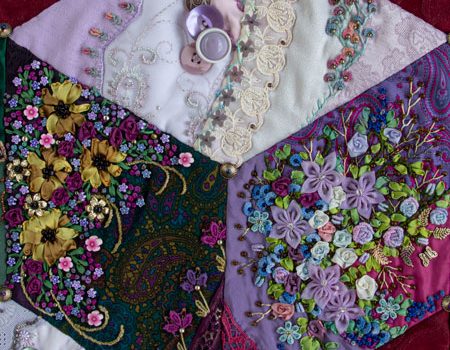Tumbling Block 4 is part of a series that offers a free block pattern and descriptions of crazy quilting techniques used. Published every month, this article is part of the Diamonds are Forever crazy quilt stitch along.
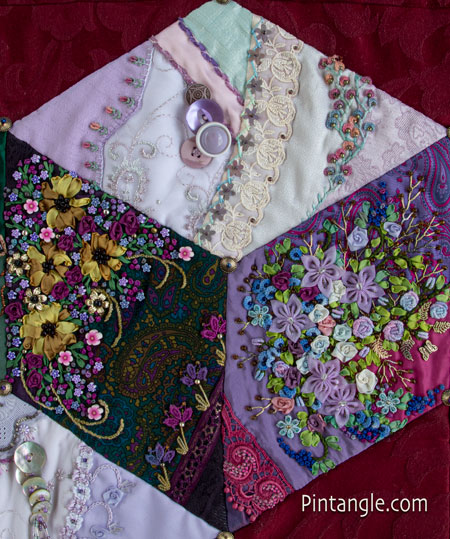
You can download the pattern for the three diamonds that make up tumbling block 4. Here is light tone diamond 1, mid tone diamond 2, dark tone diamond 3. The pdf file is to scale, but it has no seam allowances. Be sure to set your printer to print to the actual size. Do not use the ‘fit to page’ option as it will reduce the diamonds by half an inch or so. When you print them out, they should have 6-inch sides. I advise you to use Adobe Acrobat™ as a PDF reader (it’s free).

This block sits in the top right-hand corner of the ‘Diamonds are Forever’ crazy quilt.
Tips
Remember that in crazy-quilting there are no rules. When embellishing, you can follow what I have done, or adapt my ideas to your liking. Embellish as you see fit, and have fun. That is the key — to relax and enjoy yourself. Crazy quilting celebrates invention and creativity, so being different is OK. Crazy quilters constantly take an idea, adapt it, and turn it into something else. That is part of the joy and freedom of crazy quilting.
If you want to learn how to do the curved seams take a look at Curved Foundation Piecing – A tutorial which is written by Allison Aller
Light toned Diamond in Tumbling block 4
The Light toned Diamond is probably the simplest of the diamonds in tumbling block 4
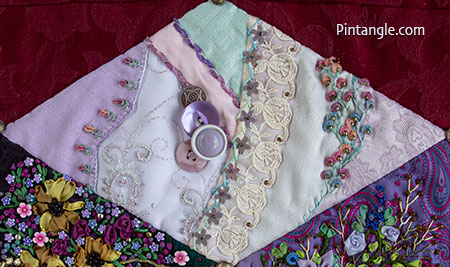
On this diamond, there is a tricky curved-shaped seam between patch 5 and 2. The pdf for this diamond block is here. Since I stitch all my blocks to a foundation, I treated this piece as I would an appliqué. I kept the process simple, and overlapped the piece of fabric over patch 2 and folded a very small seam under, then secured it with small stitches before I embroidered over the seam. I used a line of Buttonhole stitch worked in hand-dyed cotton perle #8 thread. The little rose buds are two Bullion knots worked side by side in hand-dyed wool. Fly stitches in green stranded-floss are used to represent the leaves.
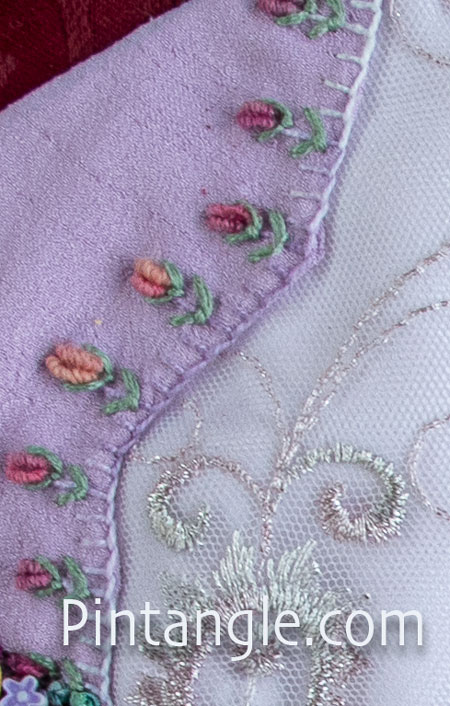
Two fabrics make up patch 2. The first was a light mauve satin, which I covered with a net fabric that was embroidered on a commercial machine.
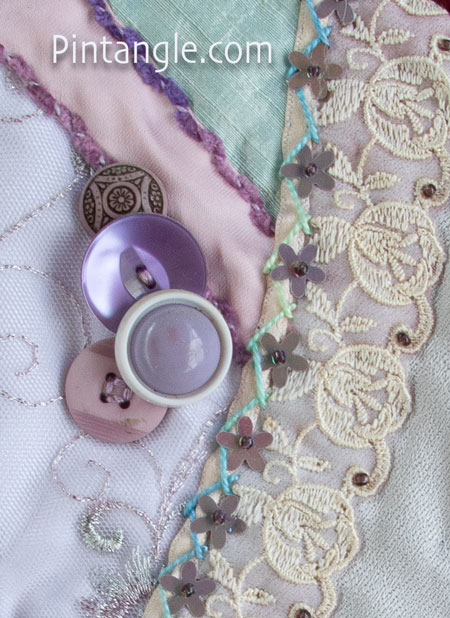
Using ribbon
I covered the seam between patch 1 and 2 with a satin ribbon. Along the edge of the ribbon, I worked a line of Running stitch, which I then threaded with a chenille thread. Vintage lace runs alongside patch 3. I first secured the lace with small stitches and then covered the edge of the lace with a satin ribbon. Over the ribbon, I worked Herringbone stitch using a hand-dyed cotton perle 8 thread. Between the spaces of the Herringbone stitch, I added a flower-shaped sequin secured with a bead. There is also a cluster of modern plastic buttons in this area.

For the seam between patch 3 and 4, I worked cast on stitch flowers in the same wool thread that I used for the bullion knot rosebuds at the other end of the diamond. Each flower has a little gold bead in the middle. I used Feather stitch for the stem.
Mid toned Diamond
If you look carefully at this block, it has 4 patches of fabric on it. It is a very easily pieced diamond this time, but I have to confess to getting carried away with the floral spray on this.
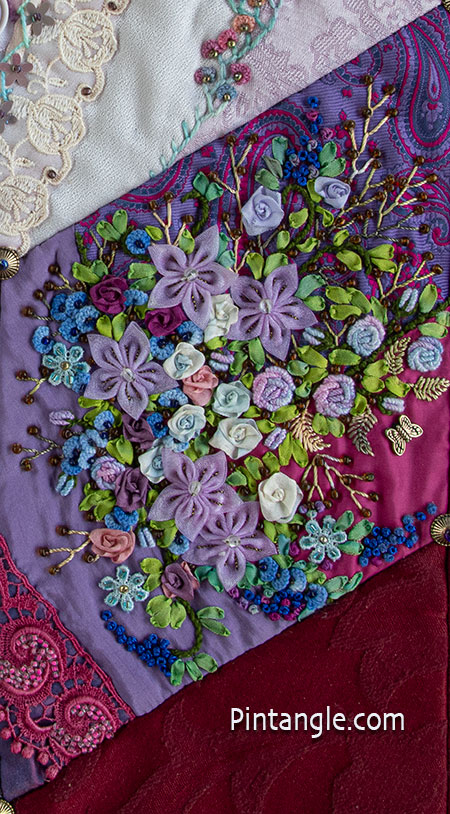
If you did not want to work so much embroidery, I am sure it would work too, particularly since there is another large floral spray on the dark diamond. Usually, if I have a large spray on one diamond I kept things in control on the other diamonds but obviously, with this block I just let loose and had a party!
How to create the effect
So what did I do here to create such an abundant effect? If you look at the pattern sheet which you can download I have marked out where I placed various flowers. The largest mauve flowers are commercial ribbon flower motifs that I collected somewhere along the way. These have a diameter of about an inch and any 1-inch ribbon flower or lace flower would work in this pattern. Or you can use my tutorial for a Five point ribbon flower
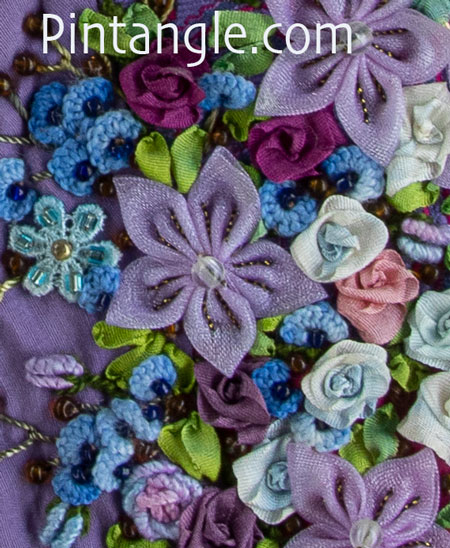
Other floral bits in this spray are: a Fargo rose which you will find a tutorial here.
I cut out some lace flowers and used Bullion knot Roses, Cast-on stitch flowers and Fly stitch leaf. I interspersed them all with silk ribbon leaf stitch p 133 in my book The Visual Guide to Crazy Quilting Design.
As I have said before, and I can’t stress this enough, one of the reasons I love crazy quilting is that there are no rules in Crazy Quilting! As traditional techniques go, crazy quilting is a remarkably easygoing, freeform style. Doing something different is OK! Crazy quilters constantly adapt or take an idea and turn it into something else. So relax and have fun with this floral spray.

The last patch of fabric ie piece 4 on the pattern has the seam covered with some hand-dyed burgundy lace. I added beads to parts of the pattern in the lace. There is a close-up above to show you what I mean. It’s a very easy technique.
Dark Toned Diamond
I have another floral spray that dominates the dark diamond. You can download the PDF file here.
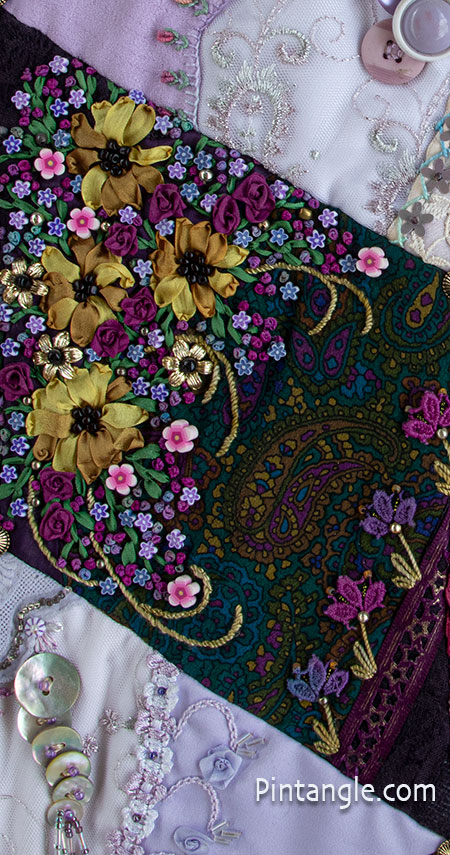
The yellow daisies — which are about an inch across — are made up of silk ribbon leaf stitch (p 133 in my book The Visual Guide to Crazy Quilting Design). I worked the stitches in a circle and filled the middle with seed beads. The flower-shaped beads were all from my stash. I chose 3 sizes to create variety.
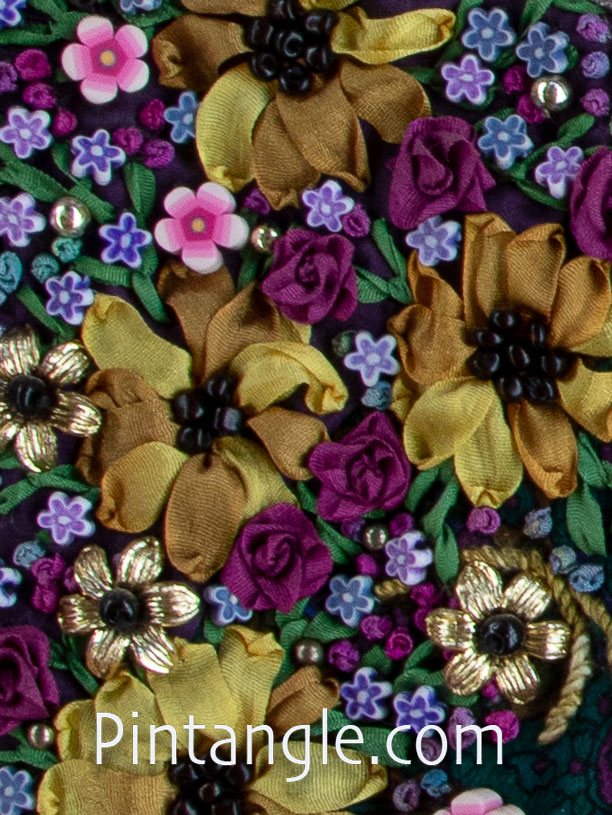
The Fargo roses are scattered across the diamond and then I tucked French knots in and around Feather stitches. I worked these in silk ribbon. Using a white chalk quilters pencil because the fabric is dark, I traced the tendril/stems using my stitchers templates. Then I worked the tendril/stems in Stem stitch using a silk buttonhole twist.
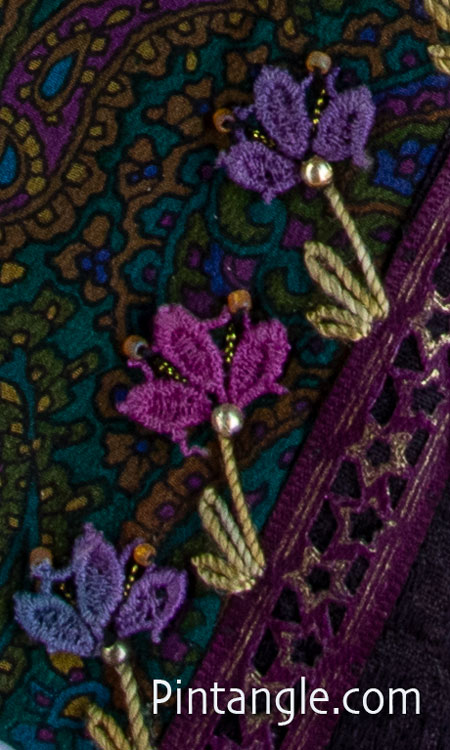
The last detail on this block is a seam that was first covered with a ribbon. Along the edge of the ribbon, I used small hand-dyed lace flowers. I cut the 6-petal flowers in half. And I finished them with straight-stitch and Detached chain stitch for stems and leaves. The green-gold thread is silk. Between the petals of the flowers, I worked a straight-stitch in metallic thread topped with a seed bead.
If you are stitching along please share what you do in either of the Crazy Quilt Divas and/or Crazy Quilt International groups on Facebook.
The quilt is on the front of two of my books: The Visual Guide to Crazy Quilting Design and my new book Crazy Quilting for Beginners Handy Pocket Guide. You do not need my books to join in on this stitch along, but I strongly recommend that you have at least the pocket guide, if not the full Visual Guide to Crazy Quilting Design.
Previous blocks in the series
Guidelines and general information about the series:
Tumbling Block 1;
Tumbling Block 2;
Tumbling Block 3;
Tumbling Block 4;
Tumbling Block 5;
Tumbling Block 6;
Tumbling Block 7;
Tumbling Block 8;
Tumbling Block 9:
Tumbling Block 10:
Tumbling Block 11:
Tumbling Block 12:
Tumbling Block 13:
Tumbling Block 14:
Tumbling Block 15:
Tumbling Block 16:
Tumbling Block 17:
Tumbling Block 18:
Tumbling Block 19:
Tumbling Block 20:
Tumbling Block 21:
Follow Pintangle and have it delivered to your inbox
You can have Pintangle including TAST delivered to your inbox — just type in your email address and click on the Subscribe button below. Then check your email inbox for a confirmation email and click the link to confirm your subscription. If you don’t see a confirmation email, check your spam folder — sometimes the computer puts it there.
The next tumbling block in the series will be on May 11th. (I publish a block each month on the second Thursday of the month)
Have you seen my Crazy Quilting book?
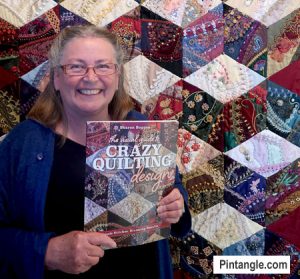
My book The Visual Guide to Crazy Quilting Design: Simple Stitches, Stunning Results shares detailed practical methods about how to design and make a crazy quilt. From fabric choice, to balancing colour, texture, and pattern, in order to balance and direct the eye around the block. I cover how to stitch, build decorative seam treatments in interesting and creative ways. My book is profusely illustrated as my aim is to be practical and inspiring.
Please note if you buy one of my books via this link as an Amazon Associate, I earn from qualifying purchases.

